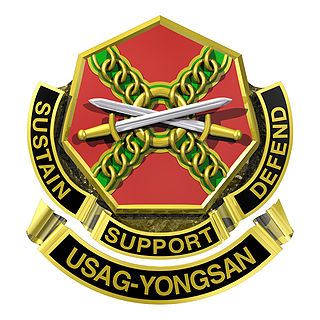
Yongsan Garrison, meaning "dragon hill garrison", is an area located in the Yongsan District of central Seoul, South Korea. The site served as the headquarters for U.S. military forces stationed in South Korea, known as United States Forces Korea (USFK), and as United States Army Garrison Yongsan (USAG-Yongsan) until 2018, under the supervision of the U.S. Army's Installation Management Command Pacific Region. From 1910 to 1945 it served as headquarters for the Imperial Japanese Army in Korea.
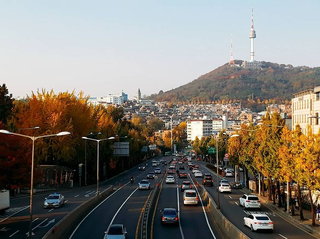
Yongsan District is one of the 25 districts of Seoul, South Korea.

Itaewon is a multi-cultural commercial area located in Seoul, South Korea. It is one of the most popular neighborhoods in Seoul, known for its nightlife and trendy restaurants.

Yeongdeungpo District is an administrative district in southwest Seoul, South Korea. Although the origin of the name is uncertain, the first two syllables are thought to be from "yeongdeung" (靈登) or "divine ascent", a shamanic rite. The third syllable is "po", representing the bank of a river (浦), referring to the district's position on the Han River. The 2006 population was 408,819.

Seocho District is one of the 25 local government districts which make up the city of Seoul, South Korea. Seocho is a part of the Gangnam region, along with the Gangnam district of Seoul. Seocho District ranks as one of the richest neighborhoods in South Korea and among the most expensive areas in Seoul with an average sales price of 47.75 million South Korean won per 3.3 square meters. Many of the wealthiest residents are concentrated in the three Gangnam districts including Seocho, known as Gangnam School District Eight.
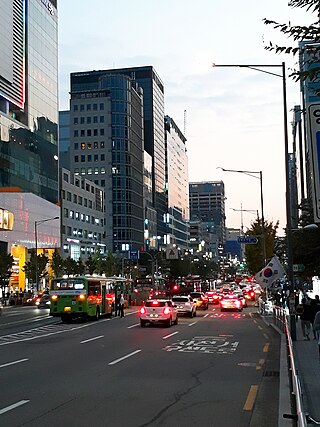
Mapo District is one of the 25 districts of Seoul, South Korea.

Seorae Village (Korean: 서래마을), sometimes nicknamed "Montmartre", due to its hilltop location, or sometimes "French Village", is a small, affluent French ethnic enclave in Banpo-dong & Bangbae-dong, Seocho District, Seoul, South Korea. It is home to about 560 French people, roughly 40% of the French community in South Korea. Most of them are employees of French corporations doing business in the country. The majority (370) of the French population are children.
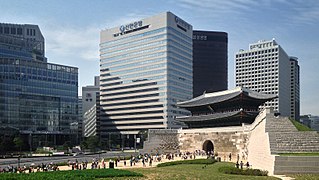
Jung District is one of the 25 districts of Seoul, South Korea.
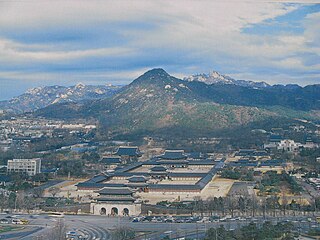
Jongno District is a district in Downtown Seoul, South Korea. It is the historic center of Seoul, and contains the Joseon-era royal palace Gyeongbokgung and the former presidential residence, the Blue House.

Yongsan-dong is a ward of Yongsan-gu in Seoul, South Korea.

Huam-dong is a dong (neighborhood) of Yongsan District, Seoul, South Korea.

Hannam-dong (Korean: 한남동) is a wealthy dong (neighborhood)of Yongsan District, Seoul, South Korea. It has been portrayed continuously in South Korea's popular culture as an oasis of wealth and luxury, thus becoming the subject of numerous domestic films, television series, and popular music references.
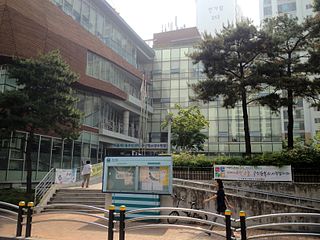
Ichon-dong is a neighborhood of Yongsan District, Seoul, South Korea. It is located in the southwest of the city proper, along the Han River.

Wonhyoro-dong is a dong, neighbourhood of Yongsan-gu in Seoul, South Korea.

Namyeong-dong is a dong, neighbourhood of Yongsan-gu in Seoul, South Korea.
Munbae-dong is a dong, neighbourhood of Yongsan-gu in Seoul, South Korea. It is a legal dong administered under its administrative dong, Hangangno 1-dong
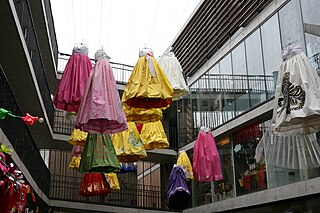
Seoul, the capital of South Korea, has many shopping areas and markets throughout the city. Famous ones include Myeong-dong, Cheongdam-dong, the Hongdae area, and the Dongdaemun and Namdaemun markets.
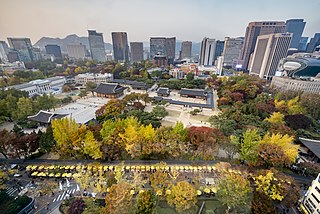
Seoul, officially Seoul Special City, is the capital and largest city of South Korea. The broader Seoul Capital Area, encompassing Gyeonggi province and Incheon Metropolitan City, emerged as the world's sixth largest metropolitan economy in 2022, trailing behind Paris, San Francisco, Los Angeles, Tokyo, and New York, and hosts more than half of South Korea's population. Although Seoul's population peaked at slightly over 10 million, it has gradually decreased since 2014, standing at approximately 9.97 million residents as of 2020. Seoul is the seat of the South Korean government.

The German School Seoul International is a German international school in Hannam-dong, Yongsan District, Seoul, South Korea.
Founded in October 2008, 10 Magazine is an English language, "events-led" monthly magazine published in Seoul, South Korea. The content focuses on the month's events around the country and entertaining activities to experience while visiting or residing in Korea.


















